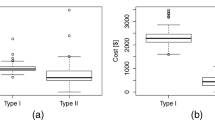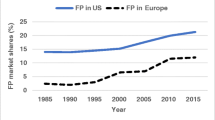Abstract
This paper presents an integer programming formulation for the hospital re-planning problem which arises after hospital network mergers. The model finds the best re-allocation of resources among hospitals, the assignment of patients to hospitals and the service portfolio to minimize the system costs subject to quality and capacity constraints. An application in the Turkish hospital networks case is illustrated to show the implications of consolidation of health insurance funds on resource allocations and flow of patients in the system.
Similar content being viewed by others
Notes
The number of dependents per insured for the year 2004 was found to be 4.4 according to the statistics provided by SSK in 2007 (SSK, 2007); hence 4 is a reasonable approximation.
References
Bretthauer K and Cote M (1998). A model for planning resource requirements in health care organizations. Decis Sci 29(1): 243.
Chu S and Chu L (2000). A modeling framework for hospital location and service allocation. Int Trans Opl Res 7: 539–569.
Clement J, McCue M, Luke R, Bramble J, Rossiter L, Ozcan Y and Pai C-W (1997). Strategic hospital alliances: Impact on financial performance. Health Aff 16: 193–203.
Connor R, Feldman R, Dowd B and Radcliff T (1997). Which types of hospital mergers save consumers money? Health Aff 16(6): 62–74.
Dokmeci V (1977). A quantitative model to plan regional health facility systems. Mngt Sci 24: 411–419.
The Economist (1999). How to make mergers work. January 9, pp. 15–16.
Galvao R, Espejo L and Boffey B (2002). A hierarchical model for the location of perinatal facilities in the municipality of Rio de Janerio. Eur J Opl Res 138: 495–517.
Geller N and Yochmowitz M (1975). Regional planning of maternity services. Health Serv Res 10: 63–75.
Güneş E and Yaman H (2005). Modeling change in a health system: Implications on patient flows and resource allocations. Clin Invest Med 28: 331–333.
Gupta D and Gerchak Y (2002). Quantifying operational synergies in a merger and acquisiton. Mngt Sci 48: 517–533.
Harper P, Shahani A, Gallagher J and Bowie C (2005). Planning health services with explicit geographical considerations: A stochastic location–allocation approach. Omega 33: 141–152.
Harris J, Ozgen H and Ozcan Y (2000). Do mergers enhance the performance of hospital efficiency? J Opl Res Soc 51: 801–811.
Iyer A and Jain A (2004). Modeling the impact of merging capacity in production–inventory systems. Mngt Sci 50: 1082–1094.
Japsen B (1996). Another record year for dealmaking. Modern Healthcare 26 (52): 37–38, 40–41, 44–46.
Morlock L, Waters H, Lyles A, Ozsari S and Aktulay G (2004). A healthy future: Solution suggestions applicable in the health reform. TUSIAD Report, Ankara.
Rahman S and Smith D (1999). Deployment of rural health facilities in a developing country. J Opl Res Soc 50: 892–902.
Rahman S and Smith D (2000). Use of location–allocation models in health service development planning in developing nations. Eur J Opl Res 123: 437–452.
Ruth R (1981). A mixed integer programming model for regional planning of a hospital inpatient service. Mngt Sci 27: 521–533.
Sherman D and Rupert T (2005). Do bank mergers have hidden or foregone value? Realized and unrealized operating synergies in one bank merger. Eur J Opl Res 168: 253–268.
SSK (2007). Statistics Yearbook for the SSK insured population. SSK website, http://www.ssk.gov.tr, accessed 14 January 2008.
Statistics Yearbook (2004). Statistics Yearbook for the Inpatient Treatment Facilities. Turkish Republic Ministry of Health Website, http://www.saglik.gov.tr/istatistikler/ytkiy2004, accessed 5 Jan 2009.
Stummer C, Doerner K, Focke A and Heidenberger K (2004). Determining location and size of medical departments in a hospital network: A multiobjective decision support approach. Health Care Mngt Sci 7: 63–71.
Verter V and Lapierre S (2002). Location of preventive health care facilities. Ann Opns Res 110: 121–130.
Weil T (2000). How to enhance the efficacy of health network growth. Int J Health Plann Mngt 15: 17–38.
World Bank (2003). Reforming the health sector for improved access and efficiency. Report no. 24358-tu.
World Bank (2004). Project information document—appraisal stage. Report no. Ab711.
Author information
Authors and Affiliations
Corresponding author
Rights and permissions
About this article
Cite this article
Güneş, E., Yaman, H. Health network mergers and hospital re-planning. J Oper Res Soc 61, 275–283 (2010). https://doi.org/10.1057/jors.2008.165
Received:
Accepted:
Published:
Issue Date:
DOI: https://doi.org/10.1057/jors.2008.165




